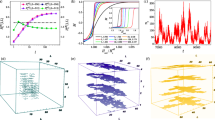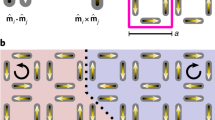Abstract
Most physical and biological systems are disordered, even though the majority of theoretical models treat disorder as a weak perturbation. One particularly simple system is a ferromagnet approaching its Curie temperature, TC, where all of the spins associated with partially filled atomic shells acquire parallel orientation. With the addition of disorder by way of chemical substitution, the Curie point is suppressed, but no qualitatively new phenomena appear in bulk measurements as long as the disorder is truly random on the atomic scale and not so large as to eliminate ferromagnetism entirely1. Here we report the discovery that a simply measured magnetic response is singular above the Curie temperature of a model, disordered magnet, and that the associated singularity grows to an anomalous divergence at TC. The origin of the singular response is the random internal field induced by an external magnetic field transverse to the favoured direction for magnetization2,3,4. The fact that ferromagnets can be studied easily and with high precision using bulk susceptibility and a large variety of imaging tools will not only advance fundamental studies of the random field problem, but also suggests a mechanism for tuning the strength of domain wall pinning, the key to applications.
This is a preview of subscription content, access via your institution
Access options
Subscribe to this journal
Receive 51 print issues and online access
$199.00 per year
only $3.90 per issue
Buy this article
- Purchase on Springer Link
- Instant access to full article PDF
Prices may be subject to local taxes which are calculated during checkout




Similar content being viewed by others
References
Reich, D. H. et al. Dipolar magnets and glasses: Neutron-scattering, dynamical, and calorimetric studies of randomly distributed Ising spins. Phys. Rev. B 42, 4631–4644 (1990)
Tabei, S. M. A., Gingras, M. J. P., Kao, Y.-J., Stasiak, P. & Fortin, J.-Y. Induced random fields in the LiHoxY1-xF4 quantum Ising magnet in a transverse magnetic field. Phys. Rev. Lett. 97, 237203 (2006)
Schechter, M. LiHoxY1-xF4 as a random field Ising ferromagnet. Preprint at 〈http://arxiv.org/cond-mat/0611063〉 (2006)
Ghosh, S., Rosenbaum, T. F., Aeppli, G. & Coppersmith, S. N. Entangled quantum state of magnetic dipoles. Nature 425, 48–51 (2003)
Ma, S. K. Modern Theory of Critical Phenomena (Addison-Wesley, Reading, Massachusetts, 1976)
Fishman, S. & Aharony, A. Random field effects in disordered anisotropic anti-ferromagnets. J. Phys. C 12, L729–L733 (1979)
Gofman, M. et al. Critical behavior of the random-field Ising model. Phys. Rev. B 53, 6362–6384 (1996)
Yoshizawa, H. et al. Random-field effects in two- and three-dimensional Ising antiferromagnets. Phys. Rev. Lett. 48, 438–441 (1982)
Ferreira, I. B., King, A. R., Jaccarino, V., Cardy, J. L. & Guggenheim, H. J. Random-field-induced destruction of the phase transition of a diluted two-dimensional Ising antiferromagnet: Rb2Co0.85Mg0.15F4 . Phys. Rev. B 28, 5192–5198 (1983)
Belanger, D. P., King, A. R., Jaccarino, V. & Cardy, J. L. Random-field critical behavior of a d = 3 Ising system. Phys. Rev. B 28, 2522–2526 (1983)
Birgeneau, R. J. et al. Critical behavior of a site-diluted three-dimensional Ising magnet. Phys. Rev. B 27, 6747–6753 (1983)
Belanger, D. P. & Young, A. P. The random field Ising model. J. Magn. Magn. Mater. 100, 272–291 (1991)
Belanger, D. P. & Yoshizawa, H. Neutron scattering and the critical behavior of the three-dimensional Ising magnet FeF2 . Phys. Rev. B 35, 4823–4830 (1987)
Slanic, Z., Belanger, D. P. & Fernandez-Baca, J. A. Equilibrium random-field Ising critical scattering in the antiferromagnet Fe0.93Zn0.07F2 . Phys. Rev. Lett. 82, 426–429 (1999)
Ronnow, H. M. et al. Quantum phase transition of a magnet in a spin bath. Science 308, 389–392 (2005)
Hansen, P. E., Johansson, T. & Nevald, R. Magnetic properties of lithium rare-earth fluorides: Ferromagnetism in LiErF4 and LiHoF4 and crystal-field parameters at the rare-earth and Li sites. Phys. Rev. B 12, 5315–5324 (1975)
Bitko, D., Rosenbaum, T. F. & Aeppli, G. Quantum critical behavior for a model magnet. Phys. Rev. Lett. 77, 940–943 (1996)
Wu, W., Ellman, B., Rosenbaum, T. F., Aeppli, G. & Reich, D. H. From classical to quantum glass. Phys. Rev. Lett. 67, 2076–2079 (1991)
Chakraborty, P. B., Henelius, P., Kjonsberg, H. & Sandvik, A. W. &. Girvin. S. M. Theory of the magnetic phase diagram of LiHoF4 . Phys. Rev. B 70, 144411 (2004)
Brooke, J., Bitko, D., Rosenbaum, T. F. & Aeppli, G. Quantum annealing of a disordered magnet. Science 284, 779–781 (1999)
Ghosh, S., Parthasarathy, R., Rosenbaum, T. F. & Aeppli, G. Coherent spin oscillations in a disordered magnet. Science 296, 2195–2198 (2002)
Brooke, J., Rosenbaum, T. F. & Aeppli, G. Tunable quantum tunnelling of magnetic domain walls. Nature 413, 610–613 (2001)
Bitko, D. Order and Disorder in a Model Quantum Magnet.Ph.D. thesis, Univ. Chicago. (1997)
Aharony, A. & Halperin, B. I. Exact relations among amplitudes at critical points of marginal dimensionality. Phys. Rev. Lett. 35, 1308–1310 (1975)
Brezin, E. & Zinn-Justin, J. Critical behavior of uniaxial systems with strong dipolar interactions. Phys. Rev. B 13, 251–254 (1976)
Ahlers, G., Kornblit, A. & Guggenheim, H. J. Logarithmic corrections to the Landau specific heat near the Curie temperature of the dipolar Ising ferromagnet LiTbF4 . Phys. Rev. Lett. 34, 1227–1230 (1975)
Griffiths, R. B. Nonanalytic behavior above the critical point in a random Ising ferromagnet. Phys. Rev. Lett. 23, 17–19 (1969)
Acknowledgements
The work at the University of Chicago was supported by the US Department of Energy and the MRSEC programme of the US National Science Foundation, while work in London was supported by the UK Engineering and Physical Sciences Research Council and a Wolfson-Royal Society Research Merit Award.
Author information
Authors and Affiliations
Corresponding author
Ethics declarations
Competing interests
Reprints and permissions information is available at www.nature.com/reprints. The authors declare no competing financial interests.
Rights and permissions
About this article
Cite this article
Silevitch, D., Bitko, D., Brooke, J. et al. A ferromagnet in a continuously tunable random field. Nature 448, 567–570 (2007). https://doi.org/10.1038/nature06050
Received:
Accepted:
Issue Date:
DOI: https://doi.org/10.1038/nature06050
This article is cited by
-
Error measurements for a quantum annealer using the one-dimensional Ising model with twisted boundaries
npj Quantum Information (2022)
-
Tuning high-Q nonlinear dynamics in a disordered quantum magnet
Nature Communications (2019)
-
Effect of random feld disorder on topological superconductors
Scientific Reports (2017)
-
Maximum-Entropy Inference with a Programmable Annealer
Scientific Reports (2016)
-
Unreachable glass transition in dilute dipolar magnet
Nature Communications (2012)
Comments
By submitting a comment you agree to abide by our Terms and Community Guidelines. If you find something abusive or that does not comply with our terms or guidelines please flag it as inappropriate.



